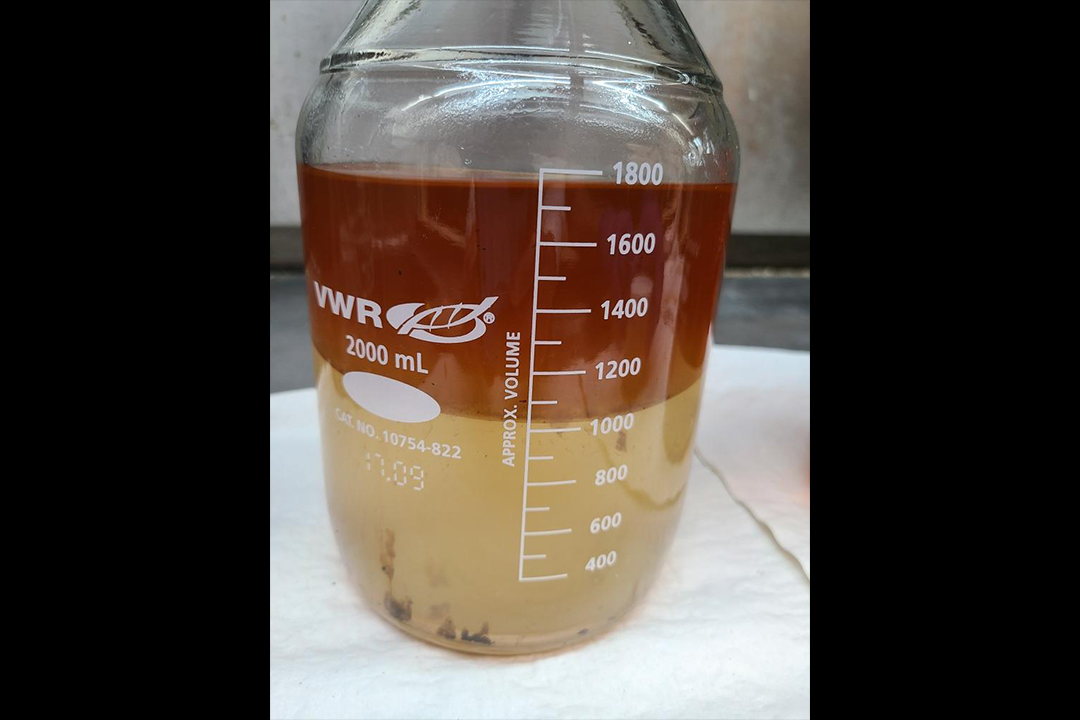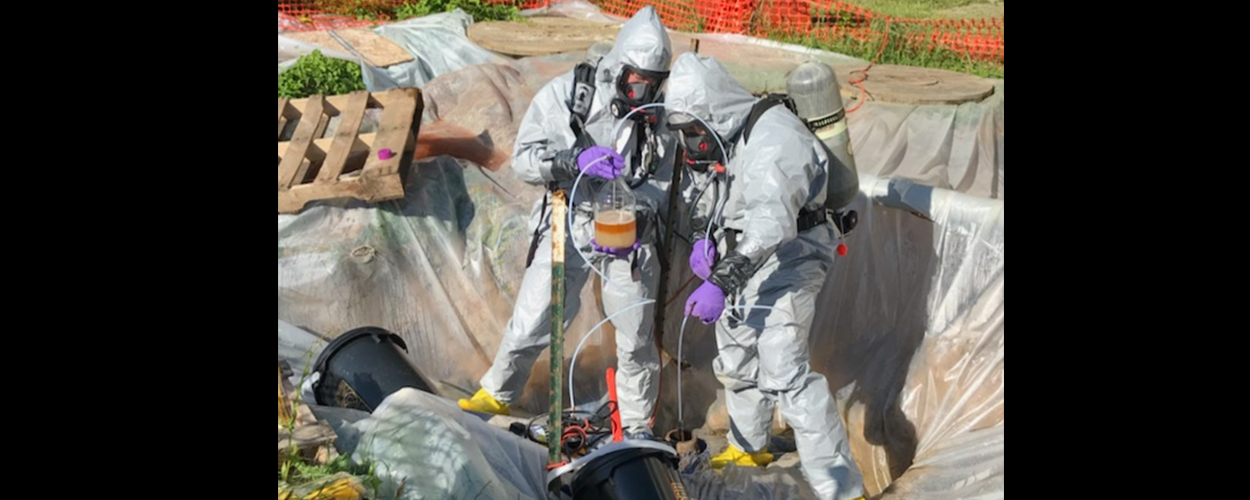Capability Spotlight: CBARR Supports APG Garrison in Mystery Storage Tank Mission
Capability Spotlight: CBARR Supports APG Garrison in Mystery Storage Tank Mission
By Robin Schumacher
Imagine you are doing your job excavating a trench, a normal day’s work, until you hit something. What is it? It appears to be an underground storage tank (UST). Then you see what looks like mercury in the soil. What do you do? This is exactly what happened this summer when an electrical utility contractor was working near a building on Aberdeen Proving Ground (APG) Edgewood Area/APG South. Luckily, the Garrison Directorate of Public Works Environmental Division (DPW-ED) knew exactly who to call.
According to Andy Murphy, an environmental protection specialist at the DPW-ED Waste Management Branch, there is historical information on the placement of most legacy USTs and other subsurface systems used to convey and/or store petroleum and hazardous substances. Most of the older underground fuel oil tanks were removed by the APG Oil Control Program in the early 1990s and were replaced with aboveground, double-walled tank systems. “That being said, surprises such as this are not uncommon,” said Murphy.
Due to the unknown nature of this particular UST and its proximity to former World War I/World War II chemical agent production facilities, the Garrison DPW-ED contacted the U.S. Army Combat Capabilities Development Command Chemical Biological Center’s (DEVCOM CBC) Chemical Biological Application and Risk Reduction (CBARR) unit. CBARR’s mission is to perform global chemical and biological operations in a safe, secure and environmentally sound manner, and response and remediation are a big part of that. When something out of the ordinary is discovered, such as a strange material, bomb, tank, or other anomaly, CBARR is one of the first groups involved because of Edgewood’s history with chemical warfare agents (CWA). In fact, CBARR has 200 field deployable scientists, engineers, technicians and operators who provide chemical biological support worldwide. This is what makes them unique from typical lab work — they are actually putting on hazmat suits and going into the field.
When it came to this operation, CBARR brought not only its expertise on how to conduct the mission, but how to accomplish it safely. They know what personal protective equipment (PPE) to use, how to gather the sample and how to keep the surrounding areas safe. The first step for CBARR in operations like this is to develop a job safety analysis (JSA). “The JSA is the gateway to everything. It lists the steps to do the job, identifies potential hazards for each and addresses how to mitigate these hazards. It is driven by safety from beginning to end,” said Brandon Bruey, a supervisory chemist in the Chemical Biological Operations Branch. The team begins gathering supplies and, once the plan is approved, they begin the operation. This process is usually accomplished within a week.
Initial analysis on the UST sample was performed by CBARR’s Environmental Monitoring Lab (EML). Lab samples typically have a turn-around time of 72 hours; however, because of the nature of this project, the results came back within 24 hours despite the work restrictions imposed due to the COVID-19 outbreak. The testing conducted by the EML was critical as it was able to confirm that no chemical agent was present in the UST. The EML can tentatively identify what is in a sample, but, more specifically, its mission is to determine what is not in a sample. “We typically contact CBARR and request their assistance in screening these materials to rule out hazards for which our contract environmental laboratories are not qualified or prepared to handle,” said Murphy.
Once any CWA was ruled out, the Garrison was able to safely send out samples to commercial labs to conduct additional analysis required to identify the contents for disposal. Bruey stressed, “If EML didn’t do their step first, we could potentially be sending a highly dangerous material to a lab that is not equipped to safely handle it.”
The team was responsive in both executing field sampling and analyses. In addition, the analytical information supplied by the CBARR lab provided ample information that pointed to #2 heating oil and water mixture. Subsequent analysis done by our environmental laboratory further reinforced this information, and provided data needed to characterize the waste fuel/water mixture for compliant off-site disposal.Andy Murphy, an environmental protection specialist at the DPW-ED Waste Management Branch
Sample analysis from the EML did indicate the presence of both water and numerous hydrocarbons, however. This suggested the long-abandoned UST was likely for storage of heating or generator fuel and has since been exposed to rain or ground water. “The team was responsive in both executing field sampling and analyses. In addition, the analytical information supplied by the CBARR lab provided ample information that pointed to #2 heating oil and water mixture. Subsequent analysis done by our environmental laboratory further reinforced this information, and provided data needed to characterize the waste fuel/water mixture for compliant off-site disposal,” added Murphy.
Another capability that makes CBARR unique is the ability to tailor sampling techniques and apparatus to the operation. In this case, because they did not know how far down the liquid was in the tank or if there was any agent present, it had to be contained in a closed system so that it was not released in the air. It also had to be rigid enough to reach the bottom of the tank, but flexible enough so that if there were two layers of liquid (i.e., oil and water) both would be collected. Using materials they had on hand, the CBARR team created a custom sampling apparatus using a vacuum pump, glassware and tubing to collect nearly four liters of a bi-phasic liquid sample from over 10 feet below ground level.
CBARR also conducts chemical agent monitoring, an important piece in a mission that could involve potential CWA. For this operation, the team deployed a Real Time Analytical Platform (RTAP), a mobile air monitoring laboratory that allowed them to conduct near-real-time monitoring using Miniature Continuous Air Monitoring Systems (MINICAMS), as well as to collect historical Depot Area Air Monitoring System (DAAMS) samples around the tank’s perimeter during the sampling operation. This ensured the protection of onsite workers as well as results that document no fugitive CWA emissions were released into the environment.
The mission was not without challenges, namely working in an environment highly contaminated with mercury and during a global pandemic. “To facilitate CBARR’s UST sampling effort and mitigate potential exposures to the mercury contamination, the Garrison covered the mercury contaminated soil with plastic. CBARR personnel also wore PPE as an additional precaution,” said Murphy. As for COVID-19 challenges, Bruey said that working remotely added an extra layer to getting the job done. For example, there were teleconferences and phone calls instead of face-to-face meetings and documents had to be emailed back and forth. Nevertheless, the team’s persistence demonstrated how the workforce could still accomplish the mission, despite the vast majority of personnel being on remote work status. The many restrictions and approvals needed to access APG just
In true CBARR fashion, several branches came together to answer the call despite the added challenges presented by COVID-19.Brandon Bruey, supervisory chemist
added another layer of effort. Because of social distancing, the team also had to look for alternative ways to do things, such as removing PPE when leaving the hot zone which is normally done with the help of other people.
All said and done, the UST sampling operation was conducted in a rapid and safe manner to provide the Garrison with the confidence needed to proceed with remediation. It is important to note that this was a team effort as there were multiple facets involved in the execution environmental, safety, lab analysis, air monitoring and mask issue, each with their respective role. “In true CBARR fashion, several branches came together to answer the call despite the added challenges presented by COVID-19,” said Bruey. He added that the successful effort was the latest in a long list of examples of how CBARR is helping to make the world a safer place.

Chemical biological operations personnel from the Center’s Chemical Biological Application and Risk Reduction unit conduct a Level-B sampling mission at the site of a discovered underground storage tank on Aberdeen Proving Ground South.

